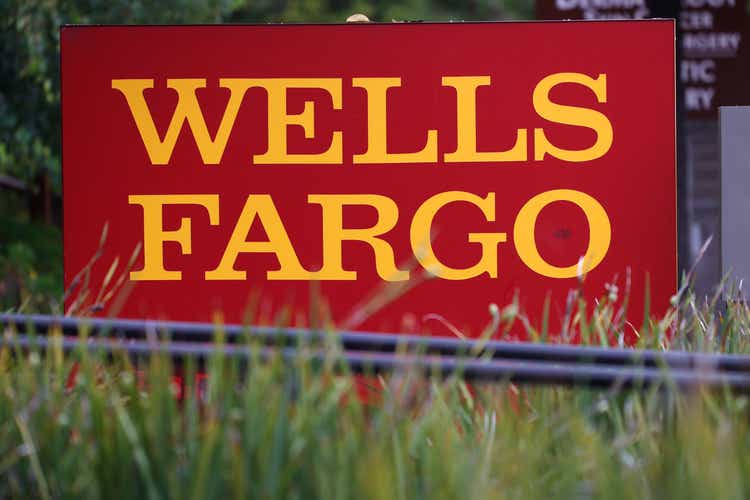
Justin Sullivan
Investors have rightfully been skittish about Wells Fargo (NYSE:WFC) in recent years, given its headline making scandals that have plagued the bank and its valuation. However, I see a lot of headwinds as already having been baked into the bank’s valuation. Investors who have shied away from the bank may want to revisit it, given its turnaround efforts. This article highlights whether WFC is currently a buy or hold, so let’s get started.
Why WFC?
Wells Fargo is one of the top 3 banks in the U.S., with around $1.9 trillion in balance sheet assets. It serves consumer banking, commercial banking, corporate and investment banking, and wealth and investment management. It’s also nearly entirely focused on the domestic, making it not directly affected by global tensions compared to its global-focused peer, Citigroup (C).
Despite all the headwinds WFC has seen in recent years, it remains one of the top deposit gatherers in the U.S., sitting behind larger peers JPMorgan Chase (JPM) and Bank of America (BAC). What sets WFC apart from its peers is its very large branch network, making it a go-to bank among many businesses, especially across the middle-market space. This large footprint also gives WFC additional consumer touchpoints to provide its more profitable wealth and advisory services.
Of course, WFC is also seeing its fair share of headwinds, with revenue declining by 16% YoY to $17.0 billion during the second quarter. While it’s seeing benefits from higher loan balances and interest rates, these were more than offset by lower non-interest income as economic volatility negatively impacted its VC, mortgage banking, investment banking, and wealth management lines of business.
On the plus side, WFC did see average deposits grow by 1%, to $1.4 trillion. I’m encouraged to see that WFC is turning the corner in its consumer business, as it’s being competitive with its fourth new credit card offering this year. WFC is seeing momentum in its growing consumer credit card business, with new accounts up 60% from last year. Management is also seeking to burnish its image with consumers by rolling out changes to its overdraft policy, giving customers a 25-hour grace period to cure negative balances before incurring a fee.
Looking forward, I would expect for many of these headwinds to persist in Q3 and perhaps for the remainder of the year. This is considering the fact that the Federal Reserve again raised interest rates by 75 basis points this month. While that will be a positive for Wells Fargo’s interest bearing loans, negative investor sentiment could drive lower loan activity as well as lower the value of fee-bearing assets under management in its wealth management group. Moreover, WFC remains under an asset cap imposed by the Federal Reserve, and that may not be lifted this year. Morningstar sees a continued multiyear rebuild process for a full transition to take place, as noted in its recent analyst report:
Wells Fargo remains in the middle of a multiyear rebuild. The bank is still under an asset cap imposed by the Federal Reserve, and we don’t see this restriction coming off in 2022. Wells Fargo has years of expense savings related projects ahead of it as the bank attempts to get its efficiency ratio back under 60%.
We also see a multiyear journey of repositioning and investing in the firm’s existing franchises, including growing its capital markets wallet share, bringing an increased focus on cards, and revitalizing an advisory group that has lost advisors for years. We’re already starting to see glimpses of the transition to offense from defense, as the bank released two new card products in 2021, the first attempt to do so that we can think of in years. However, we expect the full transition to be a multiyear undertaking.
Meanwhile, WFC maintains a BBB+ rated balance sheet with a CET1 ratio of 10.3%, sitting above the 9.1% regulatory minimum. While its dividend yield of 2.8% isn’t too high, it’s well-covered by a 22% payout ratio, and is making its way back to the $0.50 pre-pandemic quarterly rate.
Turning to valuation, WFC appears to be good value at the current price of $42.27 with a forward PE of 9.6x. However, it’s not the only bank that’s cheap as Bank of America is trading at a forward PE of 9.7, and JPMorgan Chase has a forward PE of 9.9x.
Both of these banks are higher quality as they generate higher returns and lower efficiency ratios (the lower the better). In addition, neither BAC nor JPM cut their dividends in 2020, as was the case with WFC. As such, while WFC may be a good choice for diversification, it would need to trade at a bigger discount to its two bigger peers to be attractive.
Investor Takeaway
Overall, I’m optimistic around Wells Fargo’s turnaround efforts, but it’s going to take time. The asset cap imposed by the Federal Reserve is likely to remain in place for the foreseeable future, and that’s going to limit its ability to grow. As such, while WFC is a good diversifier and the stock is in value territory, I find its two larger peers to be more attractive on a relative basis at the moment. WFC is currently a Hold.


Be the first to comment